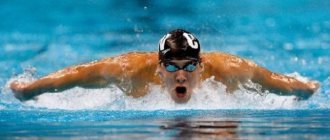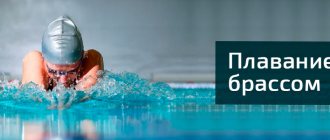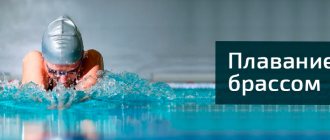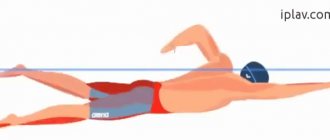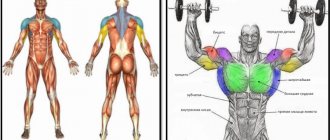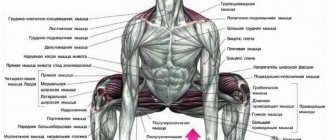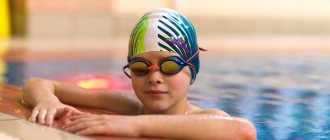Among all swimming styles, butterfly is considered not only the most difficult, but also the most beautiful. Mastering the butterfly swimming technique is the highest achievement for beginning athletes. Butterfly also requires a high level of physical fitness, so without strong muscles, endurance and a trained respiratory system, it is unlikely that you will be able to fully swim in this style. In this article we will look at all the features of the butterfly style technique in swimming, as a kind of boundary between an amateur and a professional swimmer.
How to swim correctly
The butterfly style is the most difficult swimming technique. This is explained by the need to achieve high speed, and this requires not only physical effort. What is important here is maintaining balance, coordination of movements, and coordinated work of all parts of the body.
Butterfly is similar in its technique to the movement of butterfly wings - while swimming, a person moves his arms and legs in the same way as an insect during flight. This is where the name “butterfly” came from, which means “butterfly” in English. In Russia, this style of swimming has a second name - “dolphin”, because the movements are similar to the behavior of frolicking sea inhabitants.
The butterfly swimming technique is presented as follows:
- The swimmer uses his hands to scoop up the water - this is done simultaneously with two straight arms that are thrown above his head.
- Simultaneously with the hands, the person immerses the chest lower above the water level, and the pelvis rises higher.
- The lifting of the pelvis is accompanied by the simultaneous movement of the legs - the knees drop a little lower, and the feet “push off” from the water.
As a result, it turns out that the swimmer makes two movements with which he moves forward - grabbing the water with his hands and pushing away the body with his feet. In order to stay on the water, you will have to make two push-offs with your feet for one grab of the water with your hands.
Benefit
It's beautiful and useful!
- Firstly, as mentioned above, almost all significant muscles of the body are involved - this is a very useful and good workout.
- Secondly, swimming in general and butterfly in particular is an aerobic exercise that is beneficial for the cardiovascular system.
- Thirdly, since this type of swimming is physically the most difficult, it requires the greatest energy expenditure - more calories are burned, which helps to lose excess weight.
Since swimming long distances using this method is physically difficult even for trained swimmers, a good option is to combine swimming with this style with others (crawl, breaststroke, backstroke) during training. This will not only make it possible to hold out until the end of the workout, but will also allow you to evenly use all the muscles of our body during exercise.
Movement of the body in the “dolphin” way
The presented technique must be performed in full accordance with the instructions, since only then can you get everything you need from it. Why is butterfly used? With its help, a person strengthens all the muscles of the body, which is necessary for the strength of the muscle corset and the achievement of a sculpted body. Therefore, the swimmer must take into account all the subtleties of body movement:
- The body movements are wave-like - only a sharp throw of the arms is carried out to grab the water. The rest of the body forms a kind of “wave”.
- The body moves up and down, which should be accompanied by proper breathing.
- The starting position of a person is important - he stands straight, legs together, arms raised above his head and in a straight position.
- The lifting of the upper back is accompanied by the immersion of the pelvis and legs down. Conversely, lowering the shoulder girdle entails raising the pelvis and feet.
Correct technique is achieved only by tensing the abdominal and back muscles. Therefore, a swimmer with leg or arm injuries can recover in the pool using the butterfly swimming style.
Leg movement technique
An incorrectly mastered dolphin swimming style will lead to the swimmer sinking to the bottom. And here the movements of the legs play a huge role, when the movement is performed twice as fast as grasping water with the hands.
Otherwise, it is important to follow the following rules:
- The swimmer's legs must stay together. They make wave-like movements, pushing off the water.
- The wave created by the legs is a continuation of the wave started by the arms and upper body.
- By pushing off with the legs, the person lifts the upper body upward. For a full lift, do two pushes for each lift - the first two help lift the head and shoulders, and the second two help the back.
- To push with your legs you need to bend your knees.
The leg movements in the butterfly swimming technique set the rhythm. It is the wave that is formed by the lower body that helps improve a person’s coordination on land.
Style Features
Butterfly is the most difficult swimming style of all. An unprepared person will become exhausted very quickly, so try to exercise in a pool or shallow water. But complexity is not the only characteristic of this style, let's look at other features.
- It is considered the only style in which the swimmer makes wave-like movements with the whole body.
- One of the most spectacular style among all popular techniques.
- Butterfly is the second fastest swimming style (the first is front crawl). It is optimal to use it over short distances, since over time the swimmer quickly runs out of steam and the speed drops.
- Coaches do not recommend that beginners learn the dolphin technique until they have mastered breaststroke and crawl.
- An hour of butterfly swimming can burn up to 920 kcal.
When practicing on your own, without the supervision of a trainer, it is very easy to make mistakes when learning the technique. There are too many nuances that can be overlooked. If you don’t have the money or the desire to take courses, ask a friend to watch your technique - it’s easier to notice mistakes from the outside.
Advantages and disadvantages
Butterfly is a very popular swimming style, but it is rarely used in everyday life. Basically, its relevance depends on your goals. Advantages and disadvantages should also be passed through the prism of your priorities.
Butterfly is good at short distances.
Advantages:
- Butterfly puts a serious load on many muscles, evenly developing the body, endurance and improving breathing.
- Suitable for athletes who are recovering from injuries or sprains, because... does not put stress on the musculoskeletal system.
- Helps you quickly lose weight and get your body in shape by actively burning calories (about 920 kcal/hour).
- Improves blood circulation.
- Allows you to achieve very high speeds.
- It looks beautiful and impressive from the outside.
- Swimming generally has a calming effect and helps relieve stress and tension.
But there are also negative aspects to such a popular swimming technique:
- It's difficult to learn without a trainer.
- Good physical shape and endurance are required; not everyone can cope with such loads.
- Not suitable for long distances as the swimmer will quickly become exhausted.
For those who overcome the high threshold of entry, the technique is excellent for small swims.
Contraindications
In some cases it is prohibited to train in the dolphin technique. Pregnant women and the elderly can be seriously harmed by using the butterfly stroke.
During pregnancy, it is prohibited to use the butterfly style.
In addition, the list of contraindications includes:
- Respiratory system disease.
- Digestive disorder.
- Inflammatory processes in the body, including fever.
- Cardiovascular diseases.
- Previous abdominal surgeries in the recent past.
You cannot exercise after a heart attack or stroke. In some cases this is possible, but only after the permission of the attending physician.
Hand movement technique
The hands help the athlete move the body forward, so they work not only correctly, but also in compliance with the rhythm set by the legs. The upper limbs jerk and return to the starting position.
Hand stroke
The snatch involves a stroke that is similar to the movement of breaststroke. To do this, raise both hands, palms down, then lower them sharply down and spread them in different directions. After the stroke, the limbs spread around the body. At the same time, they are half-bent at the elbows, which are located slightly higher than the forearms and hands.
Then, with an increased speed of ejection, they create a push - a strong stroke is obtained. At the same time, the upper body rises. The stroke is completed by spreading the upper limbs to the sides and then raising them.
Return to original position
The butterfly style technique in swimming begins with taking the correct starting position. At this time, the swimmer’s arms are raised up, palms pointing away from themselves - therefore, they are lowered into the water with their palms down. The return is carried out after spreading the upper limbs to the sides. The arms are in a straight position. Next, you need to lift them completely above your head, bringing them to their starting position. Then the stroke is performed in accordance with the above instructions.
Training video for beginners
This video tutorial shows the techniques of professionals in slow motion:
And here you can look at this style performed by the most titled swimmer - Michael Phelps:
As you can see, dolphin is not only a complex, but also an interesting style, having mastered which, you will be able to train many muscle groups, as well as increase your endurance. But remember that swimming in only one style during a lesson can lead to muscle clogging and fatigue, because for more effective development it is recommended to alternate different styles and do not forget about rest to restore pulse and breathing.
Basic mistakes
It is difficult to achieve perfect technique with the presented swimming style, since novice swimmers make a number of mistakes. This is due to the lack of necessary coordination of movement and proper experience. All beginning swimmers make typical mistakes when mastering the technique.
Lack of pelvic function
Beginning swimmers think that the lifting of the pelvis occurs only due to the movement of the limbs. This is wrong. When creating a wave, you have to raise your pelvis and lower it in time. The wave is done with the whole body, and not just with the legs and arms.
Improper footwork
The following common mistakes are highlighted in the question presented:
- The swimmer raises his legs too high, causing them to rise above the water level. This should not happen - your legs are under water throughout the entire swim.
- The legs do not work synchronously - with each other and with the arms.
- The swimmer pushes off by bending the knees, and the push should come from the work of the hips.
Improper technique in the lower extremities often leads to knee injuries.
Incorrect hand position when entering the water
Such a mistake results in the lack of the required stroke and the person moving forward. Hands in the starting position should be at shoulder level - extended over the shoulders. Otherwise, less force will be exerted on the water resistance, so the required push will not follow.
Low hand speed
At low speed it is impossible to make the desired stroke. Often, novice athletes go into deep water because they feel strong pressure on their shoulder joints. To avoid this, you need to work your limbs faster. Otherwise, you may get a shoulder injury.
Short stroke
Beginners also make a short stroke, which is accompanied by an increased bending of the body. Therefore, the stroke force does not correspond to the required level.
Improper breathing
Correct breathing sets the desired rhythm for raising the head. If this is not the case, neck strain occurs, which negatively affects the overall well-being of the athlete.
Stroke practice tasks
- In the shallow part of the pool, imitate rowing movements .
The athlete performs all movements: makes a stroke, brings his arms under the body to the hips and forward above the water. The athlete always strives forward, as if trying to reach something. - The next stage is to practice movements in water without support . Gliding through the water, the swimmer makes strokes without lifting his head out of the water. In this exercise, a person does not bother himself with wave-like bends of the body; he pays all his attention to practicing rowing movements.
- Then do strokes during the dolphin swim , that is, swim directly in butterfly. To begin with, the so-called “3-stroke dolphin” is suitable - the swimmer does one cycle: stroke, body wave, kick, slide, pause.
With progress, the athlete increases the number of repetitions: 5-10-15 cycles of the “3-strike dolphin” and so on. After completing the given amount, take a short rest to get comfortable.
Breathing while swimming butterfly
Swimming must be accompanied by proper breathing - this is necessary to avoid shortness of breath and increased blood pressure.
Inhale
Inhalation occurs at the moment when the swimmer's shoulder girdle rises above the water level. Therefore, you should inhale when moving the upper limbs after the stroke to the starting position. At this time, the swimmer should raise his head, look at the side of the pool and extend his arms forward for the next stroke. At the same time, take a deep and quick breath.
Exhalation
Exhale through your mouth and nose in order to do it quickly. Exhalation occurs sharply when both the nose and mouth are involved simultaneously. Otherwise, water will enter the respiratory tract and the novice swimmer may suffocate. Exhale immediately after raising your head above the water level.
Beginner swimmers do this every time - every cycle of lifting the shoulder girdle out of the water. Athletes follow a “double” cycle, when exhalation occurs every two lifts. In this way, energy is conserved, which leads to faster movement of the limbs.
History of origin
Butterfly is a modernized breaststroke. The American Henry Myers swam a similar style for the first time at a local competition in Brooklyn in 1933. At that time, this was an isolated phenomenon, but the following year, American swimming coach David Armbruster became seriously interested in the possibility of modernizing the breaststroke. He studied in detail the technique of extending his arms out of the water and created a new swimming style, which he called butterfly.
Experts of that time agreed that this method helps to increase speed over a distance, but swimming in this way is very difficult. But already in 1935, one of Armbruster’s students, swimmer Jack Sieg, modernized the work of his legs during movement, which helped to simplify the athlete’s movement in the water and speed it up even more. The teacher and student combined their work and together created the butterfly as we know it today.
Turning technique
Once the athlete has covered the length of the pool, he makes a turn. In this case, first you need to touch the side with slightly bent arms. Then they lift off the side with one hand and begin to turn it towards the opposite bank. Thus, the body follows the hand “automatically”.
After moving the body away from the side with half-bent legs, you need to touch it and turn the body completely, using support under your feet. The body takes a horizontal position on the water, after which a high-quality and strong push is made with the legs from the side.
Underwater technology
The butterfly swimming technique is suitable for moving underwater. Using the presented style, they dive to a depth in an open reservoir, and also swim some distance in the pool during competitions.
But to swim underwater, you must follow the following instructions:
- To begin with, stretch your arms up and in front of you, placing your palms together.
- Next, they dive into the water, hold their breath and make wave-like movements.
- When swimming underwater, exhale smoothly through your nose and mouth at the same time to avoid choking.
When surfacing, take a deep breath and continue swimming in the traditional way.
What muscles does it use?
To begin with, let's list which muscles work when swimming butterfly:
- Triceps;
- Shoulders;
- Latissimus dorsi muscles;
- Press;
- Large pectoralis;
- Triceps and quadriceps femoris;
- Gluteus maximus;
- Calf.
As you can see, the style comprehensively affects the muscles of almost the entire body. This is an ideal way to quickly and efficiently work out the main muscle groups without overloading the spine and joints.
Sports start
Athletes observe not only swimming technique, but also proper immersion in water. To do this, you need to stand on the side in the appropriate way for the butterfly style. Here the following sequence is observed:
- In the starting position, standing on the side, the athlete needs to first stand straight and then bend his knees slightly. Then the body is lowered at a right angle - the body is parallel to the water. There is a small distance between the feet - no more than 20 cm.
- Fingers reach the edge line.
- Hands are placed straight, back.
- At the start, the athlete needs to quickly and strongly push off from the boot, while simultaneously putting his hands forward and placing them with his palms. The arms are extended above the head for a smooth descent into the water.
They don’t dive from the side shallowly, but they don’t dive to the bottom either. The athlete must maintain a body tilt of 30 degrees to the surface of the water. They swim underwater, first slightly downwards, then parallel to the surface of the water, and then rise up. If you have problems surfacing, it is recommended to use your hands.
Exercises
— A series of swims of 3 x 200 meters, the body is extended or moving on the stomach with a board, increasing activity as swims 1-3, 4-6, 7-8 are completed.
— A series of swims of 3 x 100 meters, arms down, covering the distance at maximum speed, best average time.
Movement on the side. The lower arm is extended, the upper arm is lowered, alternating movements of the sides. This exercise allows you to work your hips behind or in front of an imaginary center line of the body.
Working with monofins. Performing pushes for 25 meters, followed by a short rest break, a series of swims of 3 x 100 meters, every 25 or 15 meters movement under water with an extended body position (alternating actions on the back and on the stomach) plus movement on the side, alternating left and right when turning over.
Vertical leg movements with load. Practicing straight vertical movements and balanced hip work.
Push and swim. A series of swims of 3 x 100 meters, the swimmer completes 50 meters using only his legs / 50 meters in the butterfly style, followed by a rest period, gradually increasing the load 1-3, 4-6, 7-8 (the sixth swim must be completed faster than the third, the eighth faster sixth).
Start. You need to do 25 repetitions; odd-numbered swims are performed underwater using only the legs, even-numbered swims are performed in the butterfly style.
Movement only with legs, arms down. The exercise is done in a mask and snorkel with or without monofins. It develops the skills of relaxing the neck muscles in the presence of water pressure, which is created by the forward movement of the head, despite its slight swaying.
